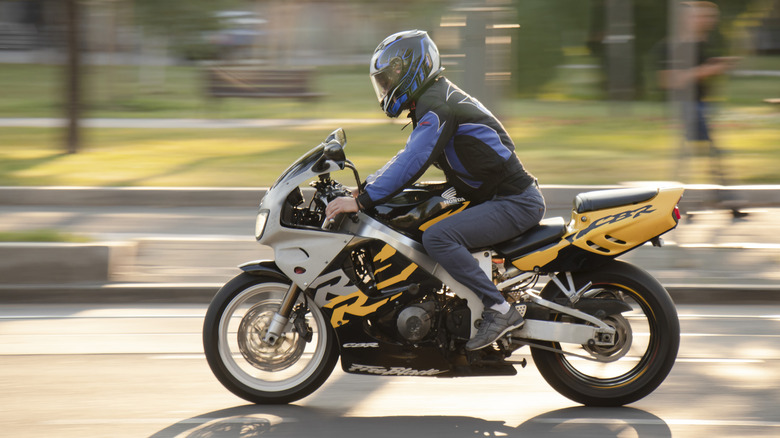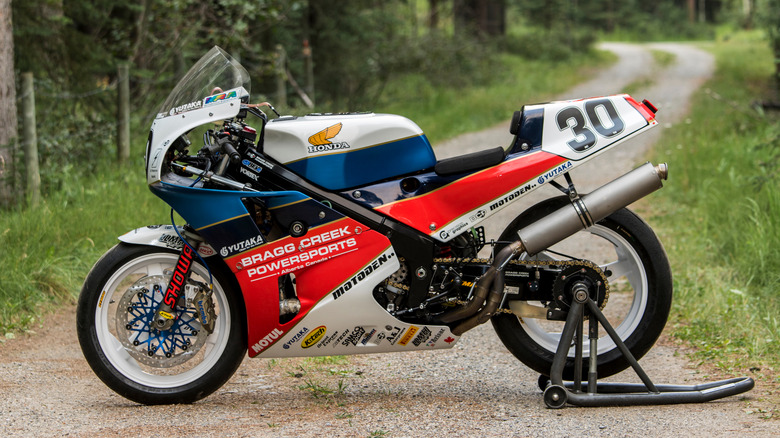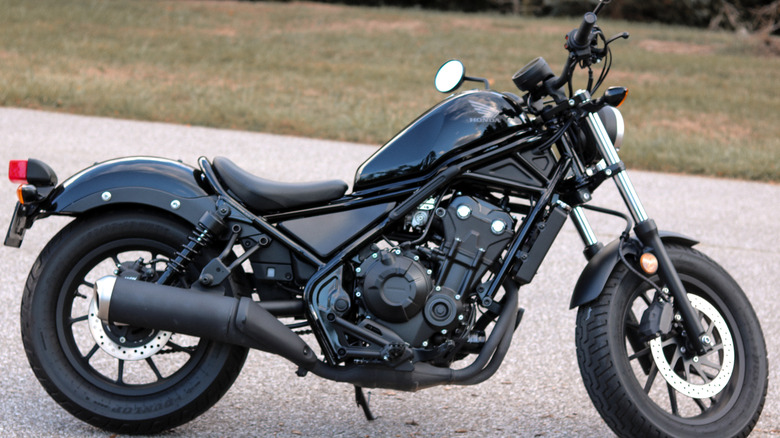
Alexlinch/Getty Images
When it comes to motorcycle design, Honda has a special talent for making bikes that are not just about performance, but also about style. The brand’s most successful motorcycles have set trends, challenged norms, and become icons in the riding community.
Advertisement
This list isn’t just about bikes that look good — it is about motorcycles that have left a mark. Some of these models introduced new design ideas, while some others perfected the classics. These are the bikes that make you stop and take a second look — whether they are sitting still or roaring down the road. They have that certain something — call it character, call it presence — that makes them hard to ignore. Honda has a way of nailing the form and function, and never failing to create bikes that speak to both the rider’s soul and sense of style.
In this rundown, you will find Honda motorcycles with a variety of styles, from a different eras. Each one has its own unique vibe and way of defining what it means to be stylish. These bikes are not just about getting from point A to point B. They are about making a statement every time they hit the road.
Advertisement
Honda CB750 (1969)
The Honda CB750 launched in 1969, and it’s in a league of its own. This is one of the most stylish motorcycles ever designed by Honda — for a few reasons. First, its design directly drew from Honda’s success in Grand Prix racing. With its four-cylinder engine, the CB750 brought the power and prestige of a race bike into a road machine, which was something rare for its time.
Advertisement
One of the bike’s defining features was its revolutionary braking system. The CB750 was the first production motorcycle to feature disc brakes, which were rare on bikes at the time. It offered a level of control and safety that set it apart.
The CB750’s inline-four engine was another feature that stood out. At a time when most large bikes were still using twin-cylinder setups, the four-muffler design gave the CB750 a unique look and sound, which immediately set it apart from the competition. In terms of ergonomics, the CB750 was not just about good looks. It was designed for long-distance touring, which made it practical as well as stylish. The combination of cutting-edge technology, thoughtful design, and sleek aesthetics made the CB750 not just a motorcycle but a cultural icon. To this day, it is remembered as one of the most drop-dead gorgeous motorcycles Honda ever put its name on.
Advertisement
Honda CBX1000 (1978)
The Honda CBX1000 is a classic Honda motorcycle that is surprisingly cheap today, but when it hit the scene in 1978, it was unlike anything else. Its six-cylinder engine alone was a statement — taking cues from Honda’s racing success with six-cylinder bikes in the 1960s, the CBX1000 brought that innovation to the street. Just the sight of those six carburetors, the engine’s size, and its angled design gave the bike a unique and imposing presence. But the style didn’t end with just the engine.
Advertisement
The CBX1000 had a naked design — meaning all of its mechanical marvels were on full display. The way they built it, with the engine itself holding up the frame, no extra tubes messing up the lines — it was not just a motorcycle, it was a piece of engineering sculpture. Honda didn’t shy away from showing off every piece of its handiwork.
Another part of the CBX1000’s appeal was the riding experience it offered. The sound alone, especially with a six-into-six exhaust, was something you’d expect from a high-performance car rather than a motorcycle. Its 105 hp at 9,000 rpm made it one of the most powerful bikes of its time, and its sleek, angular design paired perfectly with its performance.
In terms of handling, in spite of its size, the CBX1000 was surprisingly agile, offering more cornering ability than you would expect from such a large machine. The wide engine might have seemed cumbersome, but clever design kept the bike narrow enough for practical use.
Advertisement
Honda NR750 (1992)
The Honda NR750 launched in 1992 and stands out as one of the most stylish motorcycles the brand ever designed. It emerged during a time when Honda was willing to take risks, set apart by the incredible engineering behind its design — in particular, the 748cc V4 engine with oval pistons, something never before seen on a production bike. Honda developed over 200 patents for the engine alone.
Advertisement
The NR750’s aesthetics are equally impressive. Its futuristic design featured sleek and aerodynamic carbon fiber bodywork, a polished frame, and seamless welds, giving it an appearance unlike anything else on the market. The under-seat exhaust and hybrid digital-analog dash only added to the futuristic vibe. However, while the bike’s engineering might have been complex and expensive, the attention to detail is what made this bike a visual masterpiece.
Honda fused style and technology in a way that turned heads, even if the NR750 did not rack up trophies on the race track. With its limited production and groundbreaking design, the bike is now a sought-after collector’s item, leaving many to wonder exactly how many Honda NR750 motorcycles were made, and the worth one worth today. But its rarity — along with its striking design — makes it one of the most stylish motorcycles in Honda’s history — an icon of creativity and ambition.
Advertisement
[ Featured Image by Michael Gaylard from Horsham,UK via Wikimedia Commons | Cropped and scaled | CC BY-SA 2.0 ]
Honda RC30 (VFR750R) (1987)

Adam Gregory/Shutterstock
The Honda RC30 (VFR750R) is a perfect example of a stylish motorcycle. Designed in the late 1980s, this bike wasn’t simply a product of its time — it was ahead of it. Created to meet homologation requirements for the World Superbike Championship, the RC30 was essentially a race bike built for the road — a dream come true for many motorcycle enthusiasts.
Advertisement
The RC30 had a sleek and aerodynamic design. However, it wasn’t just for show — every curve and feature had a purpose. The single-sided swingarm, for instance, allowed for quick wheel changes during races. It also gave the bike a unique look that set it apart from its competitors. The RC30’s compact frame made it look light and fast, which it was — capable of reaching over 150 mph.
The bike’s iconic red, white, and blue livery helped make it one of the coolest looking Honda motorcycles ever made. The color scheme was not only eye-catching but also tied to Honda’s racing heritage. Tucked within this sleek frame, the V4 engine provided not just speed but also a sound that was unmistakably Honda. Perhaps what adds to its allure is its rarity. With only about 3,000 units made, owning one was — and still is — a mark of distinction.
Advertisement
Honda Rebel 500 (2017)

KRxMedia/Shutterstock
The 2017 Honda Rebel 500 brings a sleek and minimalist design to the world of cruiser motorcycles. The bike’s simple stripped-down aesthetic gives it a unique edge that many riders appreciate. With its exposed trellis frame and blacked-out components, the Rebel has an attitude that fits its name perfectly.
Advertisement
One of the first things that grabs your eye is its bobber-inspired look. The low-slung seat and fat tires immediately catch the attention, and the single round headlight adds a vintage touch. The compact and modern chassis brings everything together into a cohesive design. Honda also designed the Rebel as a canvas for customization, which is a big part of its appeal. The rear section can be easily removed, letting riders turn their Rebel into a full-on bobber if they want to. This flexibility allows each rider to make the bike their own, which further adds to its stylish reputation. The Rebel 500 is also one of the lowest and lightest motorcycles for shorter riders — which makes it an accessible choice.
Advertisement
The Rebel 500 is a stunner, no doubt about it, but its beauty isn’t just skin deep. Its design is a perfect blend of form and function, as fun to ride as it is to admire. The high pegs, comfortable seating position, and neutral handlebar placement make for an enjoyable ride both on city streets or the highway. Honda managed to combine practicality with style, which is definitely no easy feat.
Honda Super Cub C125 (2018)
The 2018 Honda Super Cub C125 is a medley of vintage charm and modern features. Its design — rooted in the original 1958 Super Cub — manages to stay true to its classic aesthetic while integrating modern advances such as LED lights, a smart key system, and ABS. It is like a nod to the past, with a forward-thinking approach.
Advertisement
The simplicity of the Super Cub’s design is part of its appeal. The step-through frame, single seat, and small body make it a practical urban bike, but it is the little details that elevate its style. The red seat, for example, pays homage to Honda’s founder, who was known for his love of the color red. The two-tone blue color scheme, inspired by the earth — sky and ocean — adds to the bike’s unique character.
The Super Cub isn’t just another pretty motorcycle. The design isn’t about flashy looks — it is about making riding easy and enjoyable. The automatic clutch means anyone can hop on and go — whether it is your first time or you are a seasoned rider. And its small size and light weight make zipping around city streets a breeze. With over 100 million units sold worldwide, it is clear that its stylish design is part of what has kept it so beloved for decades.
Advertisement
Honda CBR900RR Fireblade (1992)
The 1992 Honda CBR900RR Fireblade redefined what a sportbike could be. At a time when many sports bikes had become heavy and difficult to handle, the Fireblade offered a fresh perspective with its lightweight and compact design. With an unheard of 407.8-pound dry weight and an 893cc engine, it was more agile and responsive than its competitors.
Advertisement
The bike’s minimalist fairing and aggressive lines were not only visually striking but also helped reduce weight and improve aerodynamics. The bike’s twin-tube aluminum frame contributed to its sleek profile and played a significant role in its handling dynamics. Its design philosophy of «total control» meant it prioritized handling over raw power, which was a departure from the trend of the time. This approach gave the Fireblade an edge in maneuverability and made it a joy to ride both on the track and the road. Design features like the analog clocks and carbureted engine give the bike a classic yet purposeful look.
The Fireblade introduced the iconic concept of mixing high power with lightweight construction, and has influenced motorcycle design ever since. Basically, it represented an evolutionary leap for sportbikes, a shift toward more refined and rider-focused designs. It set a new standard for performance and style in a motorcycle, built for those who truly appreciated the joy of riding.
Advertisement
Honda CB1100 (2013)
The 2013 Honda CB1100 is a classic motorcycle design that combines retro aesthetics with modern engineering, falling squarely into the category of motorcycles that are dirt cheap to maintain. It draws inspiration from iconic models like the CB750K and CB900F. The standout feature is its large, air-cooled four-cylinder engine, which hearkens back to the days when engines were both functional and visually striking. With polished downpipes and a clean simple layout, the engine adds to the bike’s overall vintage charm.
Advertisement
The chrome exhausts, sculpted fuel tank, and ribbed seat all conjure up images of the classic bikes of the 1970s, but the design still feels fresh. Twin analog dials on the instrument cluster add to the retro vibe, while providing clear and straightforward information. The bike’s twin shocks and spoked wheels also contribute to its timeless look.
Riding the CB1100 is equally about the experience as it is about performance. It offers a relaxed, upright riding position, which makes it comfortable for long journeys. In spite of its 544.5-pound weight, the bike handles with surprising ease. The 1,140cc engine, while not the most powerful, delivers smooth and predictable performance. The CB1100’s styling captures the essence of Honda’s early motorcycles without being overly nostalgic.
Advertisement
Honda Valkyrie Rune (2004)
At first glance, the 2004 Honda Valkyrie Rune looks like something out of a science fiction movie — massive, sleek, and unmistakably unique. Honda went all out with the design and created a motorcycle that is both a statement and a work of art — where functionality meets bold creativity.
Advertisement
One of the most striking features of the Rune is its sheer presence. With an 1,800cc, six-cylinder engine and a weight of 888 pounds, it is a beast. But it’s also graceful, thanks to a low center of gravity and a seat height of just 27.2 inches. The headlight is shaped like something from a futuristic dream and adds to its otherworldly look. Then there is the chrome. Honda did not skimp on the shiny stuff and gave the Rune an almost sculptural quality.
But the Rune is not just about looks. Its engineering is equally impressive. Honda incorporated a trailing-link front suspension that not only catches the eye but also provides a stable and smooth ride. The flat-six engine — borrowed from the Gold Wing — is tuned for torque and delivers a powerful yet manageable riding experience. The Rune cruises effortlessly and offers a ride as smooth as it is commanding.
Advertisement
Honda RC213V-S (2015)
The 2015 Honda RC213V-S was built as a MotoGP bike for the streets — it strikes a balance between race performance and street-legal practicality. The X-factor of this bike is undoubtedly its minimalist yet aggressive design, which clearly takes inspiration from Honda’s racing pedigree.
Advertisement
Essentially, this is a race bike with lights. Its sharp and angular bodywork along with the exposed mechanical components give it an industrial yet purposeful look. The carbon fiber fairings, slim profile, and exhaust under the seat immediately signal its racing DNA. This bike doesn’t just look fast — it is engineered to be fast with a 999cc V4 engine sitting at its core. Even standing still, the bike looks like it is ready to tear up a track.
The Honda RC213V-S closely mirrors the MotoGP version. About 80% of its parts are shared with the race model, which means this is not just a road bike with a sporty paint job — it is the real deal. From the Ohlins suspension to the Brembo brakes, every element is finely tuned for performance. However, in spite of being street-legal, the bike maintains its raw and track-focused aesthetic. The single seat, aerodynamic bodywork, and GP-inspired twin exhaust layout make it clear: this machine is built for speed. The dedication to both style and performance makes the RC213V-S one of Honda’s most stylish creations.
Advertisement